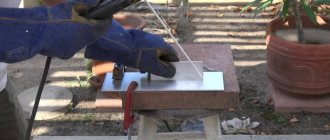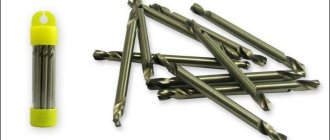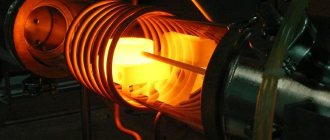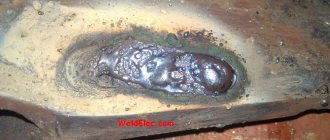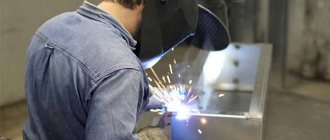The highest quality and most beautiful seams are obtained if stainless steel is joined by semi-automatic welding under argon protection. But not every home craftsman has the opportunity to purchase expensive equipment and gas. When the aesthetics of the connection is not important, the required quality is achieved by welding stainless steel with an inverter.
Advantages and disadvantages of welding stainless steel with an inverter
When comparing stainless steel welding with an inverter with other methods, the following advantages are noted:
- low price of the device;
- light weight and dimensions allow you to carry the inverter even in a bag;
- manual arc welding can be used to connect workpieces up to 20 mm thick from alloys, ferrous and non-ferrous metals;
- work is carried out without flux or inert gas;
- performing welding in hard-to-reach places.
Flaws:
- slag formation;
- due to the high electrical resistance of stainless steel, overheating of the electrode with destruction of the coating is possible, so the welding current is limited;
- more time consuming when compared to other methods.
Method using an inverter
The job requires experience and is not available to every beginner.
Advantages of welding stainless steel with a conventional electrode:
- low cost of equipment;
- low weight and dimensions of the device;
- ability to weld parts up to 2 cm thick;
- possibility of working without protective gases and fluxes.
Disadvantages of this method:
- formation of a large amount of slag;
- destruction of the coating followed by overheating of the electrode;
- current limit;
- increased time costs.
The work is carried out in three ways:
- Using manual methods. The joint between the parts is filled with molten electrode material. Only an inverter is used for operation.
- Connecting workpieces with a tungsten electrode used for thin sheets. The weld is obtained by melting the workpiece and filler wire. The welding site is protected by a layer of gas.
- Semi-automatic operation with wire feeding. Speed increases along with productivity. It is recommended to add carbon dioxide (up to 2%) to argon.
Before you cook stainless steel with an inverter at home, you need to properly prepare the apparatus and materials.
We recommend reading: How to weld stainless steel to ferrous metal
Necessary consumables
Using an inverter, you need to prepare everything necessary for work:
- unit of the appropriate type;
- solvent;
- steel bristle brush;
- personal protective equipment;
- electrodes;
- crocodiles – grounding clamps;
- cables with a length of 2 to 6 m.
Joining sheets with a thickness of 3 or 4 mm and obtaining a high-quality seam becomes a difficult task, which can be accomplished using an inverter with an oscillator and the ability to carry out argon arc welding (TAW).
The popular device Aurora PRO INTER TIG 200 PULSE can become such a device. ADS allows you to create beautiful and durable seams on thin sheets or pipes.
Inverter setup
Before welding, the machine is set up correctly. This is done by switches on the instrument panel. The required values can be seen in the table:
| Workpiece thickness | Current value (A) | Voltage (V) | Electrode diameter |
| 1,5 | 40 – 60 | 13 | 2 |
| 3,0 | 75 – 85 | 15 | 3 |
| 4,0 | 90 – 100 | 16 | 3 |
| 6,0 | 140 – 150 | 18 | 4 |
| 8,0 | 150 – 180 | 20 | 4 |
| 12,0 | 180 – 220 | 22 | 5 |
| 15,0 | 220 – 260 | 26 | 6 |
When working in semi-automatic or argon-arc welding mode, the flow rate of inert shielding gas is set. Everything is done experimentally. Optimal values are 6-12 l/min. The movement of the wire during automatic feeding is adjusted to the maximum speed, which gives a high-quality seam.
Process step by step
Before work, the master must perform the following steps:
- remove dirt from the workpiece next to the future seam with a steel brush or emery cloth until it has a natural shine;
- treat the welding area with solvent or acetone to remove traces of fat;
- remove chamfers from workpieces with a thickness of 4 mm or more to fill the joint with molten metal;
- treat the rest of the metal with a solution of chalk in water so that hot drops do not stick;
- leave a compensation gap of 1-2 mm between the parts;
- connect thin sheets without gaps;
- place heat-dissipating plates under the workpieces;
- Thick parts should first be heated until they reach 150-170°C.
We recommend reading: How to cook stainless steel in an argon environment
When working with direct current, reverse polarity is installed.
Post-weld treatment
At the end of the work, the parts are cooled naturally. You cannot speed up the process by pouring water on them. This will lead to the formation of microcracks. After cleaning the slag, the seam is ground and then polished.
For refining, abrasive materials containing aluminum or zirconium oxide are used. Corundum products are not suitable.
To ensure that the joint remains durable and aesthetically pleasing, it is coated with a paste with anti-corrosion properties. If these recommendations are not followed, the quality of the product will decrease due to the occurrence of rust spots.
Instead of a conclusion: manual welding is often used for small household and industrial problems. It is used to connect pipes, stainless steel tanks and other products in the country, in the house, in the garage. Repaired items last for many years.
Welding methods
There are three ways to weld stainless steel at home with an inverter:
- Manual arc welding (MMA), when the material of a consumable electrode is filled into the joint. To operate, you only need an inverter.
- The argon arc method (TIG) with a tungsten electrode is used for welding thin stainless steel with an inverter. The weld is created by melting the workpiece material or filler wire. The weld pool is protected from contact with ambient air by pure argon. Moving the burner with a non-consumable electrode and feeding the filler wire are performed manually.
- Semi-automatic welding (MIG/MAG) is performed with a non-consumable electrode with mechanical wire feed. By increasing the welding speed, productivity increases. To improve the wettability of the edges, 2% carbon dioxide is added to argon.
Features of the technology
Due to the physical and chemical properties of stainless steel as a metal being welded, the most optimal method is welding using a non-consumable electrode in a shielding gas (argon or its mixture can be used as such a gas). In production, to achieve higher quality welded joints, combined welding methods are used, in which the root layer of the weld is performed using argon arc welding, and subsequent layers are performed using manual arc welding.
The selection of operating parameters of the welding inverter (welding current and welding voltage parameters) is based on the following data:
- thickness of welded parts;
- type and grade of steel;
- data on the operating mode of the product or connection;
- very high coefficient of thermal expansion of stainless steel parts - when heated, a significant “stretching” of the parts occurs, and when cooled, compression occurs, which can cause the formation of microcracks in the weld, as well as in the product itself in that part of it that belongs to the welding zone and exposed to heat;
- welding should be carried out with a minimal increase in metal temperature to avoid overheating of the heat-affected zone. If overheating above 500 degrees Celsius occurs, the process of intercrystalline corrosion will begin inside the metal, which will cause destruction of the weld and the entire part as a whole, having the most negative impact on the quality of the seam.
In each specific case, it is necessary to select modes individually, carrying out a mandatory test on parts similar to those being welded. The main condition for welding stainless steel parts is to reduce the welding current compared to other types of steel by at least 20%.
The features of welding technology should also include the mandatory selection of all tools so that they comply with the rules for working with stainless steel: grinder wheels, brushes used for stripping metal must be suitable for working with stainless steel, since in the case of using conventional tools they can metal inclusions may form in the weld, which negatively affects its quality.
Which inverter is suitable for welding stainless steel
To weld stainless steel, an inverter welding machine of any brand is used. For working at home, the simplest model is chosen. Craftsmen even make homemade devices whose characteristics are not inferior to their factory counterparts. The inverter must have a manual welding mode (MMA) and current adjustment within the range of 20 - 200 A. For welding stainless steel, it is desirable to have the following options:
- “Force and Furious” mode, which allows you to briefly reduce the arc voltage while simultaneously increasing the current;
- PV (duration of continuous operation, indicated in the instructions) not less than 40%;
- the length of the cables is no more than 6 m, otherwise due to the large power loss they will become very hot;
- maintaining operability even with significant changes in voltage in the electrical network.
Note!
When choosing an inverter, you need to carefully read the instructions, since not all models can operate at low temperatures.
In this article:
It is carried out using a direct current source (inverter, rectifier, welding generator). The welder operates a holder with a consumable electrode. The electrode rod acts as a filler material, and its coating protects the weld pool from the external environment.
This is the most budget option that does not require expensive welding equipment. Consumables for it are also available. But the quality of the seams is far from ideal, although the connections can be airtight.
Manual argon tungsten electrode (TIG)
This is done using a DC source to which two cables are connected. One is the mass, and the second leads to the burner. The torch nozzle contains a tungsten electrode. It doesn't melt, so it doesn't shorten. It is easier for the welder to maintain a stable arc height, the seam is smoother, narrower, and smoother. The filler metal is additionally supplied by the welder’s second hand. The weld pool is protected by inert gas coming out of the torch nozzle.
The seams when TIG welding stainless steel are of better quality, but the process is slow. Consumables (tungsten electrodes, gas) are expensive. The equipment also differs in price from MMA to a greater extent.
Semi-automatic wire welding (MIG)
Semi-automatic welding uses direct current equipment and a feed mechanism. He pushes a wire protruding as a consumable electrode. But the length of the wire coming out of the torch nozzle remains constant, so it is easier to control the height of the arc. To protect the weld pool, gas is used, supplied from a cylinder with a reducer through a valve in the welding machine.
Semi-automatic stainless steel welding is the most productive, but is inferior in seam quality to the TIG method. Consumables for this welding method are more expensive than for RDS.
Selecting Electrodes
To weld stainless steel with a direct current inverter, it is allowed to use electrodes with a base coating based on calcium and magnesium carbonates. Popular domestic brands include OZL-8 and TsL-11. They are inexpensive, but require experience to operate. The electrodes are prone to sticking and do not hold the arc well, but the seams are obtained with sufficient anti-corrosion characteristics.
The best results are obtained if you choose universal electrodes with rutile coating for your work. They weld common grades of stainless steel using direct and alternating current. The best electrodes are OK 67.60, which are produced by the Swedish company ESAB. They light easily, hold the arc stably, and reduce the amount of molten metal splashes. When working with rutile grades, even a beginner can create a strong seam.
When manual welding, it should be taken into account that the cooling slag begins to spontaneously rebound. Therefore, at this time you need to be located at a safe distance so that it cannot get into your eyes or exposed skin.
Welding process
The welding process when manufacturing stainless steel products, as in the case of welding other metals, is divided into three stages - the preparatory stage, the welding stage itself and the final stage.
Preparation stage
At the preparatory stage, you should mark the parts that are planned to be welded, clean them, and degrease them using a special chemical composition. If this is dictated by the thickness of the parts being joined, it will also be necessary to cut the edges for better formation of the weld seam.
Main works
The main welding stage consists of the following steps:
- connecting the inverter by creating reverse polarity (the cable with the electrode holder is connected to the “+” connector, and the ground cable is connected to the “-” connector). Such a connection will ensure greater melting of the electrode compared to a connection in direct mode, as well as avoid burning through the material by reducing the penetration of parts;
- After the parts are secured in the positions in which they will be welded, primary tack welds should be made . The length of such seams and their location along the contour of the planned weld is determined depending on the size of the seam, as well as depending on the thickness of the parts being welded;
- in the event that we are talking about creating a long-length welding seam, a stepwise method should be performed , during which welding is carried out from opposite sides with short seams;
- if it is necessary to perform several layers in one seam, then after each new layer you should wait some time so that the previous layer has time to cool before applying a new one;
- in the case of a large seam (extended in distance) or if it has a complex configuration, you will need to make a larger number of tacks compared to simple or short seams , each of which will differ in a short length, located along the edges of the seam. This action will reduce the risk of deformation of parts near the seam.
Experienced advice, expert assortment
Important tips for welding stainless steel:
- The notorious ICC - intergranular corrosion , which everyone fears and talks about a lot, appears only at temperatures above 500°C. Monitoring and taking preventive measures against MCC is not practical unless the temperature reaches this level.
- The temperature must always be monitored very carefully: in the range from 350 ° C to 500 ° C , the ductility of stainless alloys is significantly reduced, and this leads to increased fragility of the metal . Avoid swinging hammers, hands or any other objects at this temperature!
- Don’t be lazy , preheat the workpieces to the highest temperatures of up to 1200°C, followed by self-cooling for at least three hours. This will improve the quality of the steel.
- There is never a need to rush, but welding stainless steel with electrodes should be carried out as quickly as possible: stainless steel does not like prolonged heating . It’s better to cook in layers, cooling each layer to 100°C before each next one.
- Ideal potholders are always long. At least try to keep the distance between the tacks of the workpieces to a minimum before applying the base layer.
- Choosing the right electrode is no less important than choosing a welding machine or welding mode. Therefore, pay no less attention to the electrodes.
We cook thin steel
This is one of the most difficult methods, requiring knowledge and skills in equal measure. In addition to accurately selecting suitable consumables, it is necessary to set the correct voltage with the current reduced by approximately 20%. You can only work with short rods - no longer than 35 mm. Do not allow high heating temperatures, the upper limit is 500°C, in no case higher.
Operating principle of MMA welding.
Household welding of thin stainless steel sheets is carried out using an inverter machine with strict production rules:
- Under no circumstances should the temperature level exceed 150°C in the joint area and general heating of surfaces.
- Use only low current values, but at high speed.
- To prevent the formation of holes and overheating of the working area, place gaskets in the form of plates under the workpieces: in this way, excess heat will dissipate.
- If the metal sheets are thinner than 3 mm, there is no need to trim the edges. The gap between the surfaces in this case should be no more than 2 mm.
The following electrodes are designed for working with thin stainless steel:
- TsL-11 , a public favorite, produces a very corrosion-resistant weld even in unfavorable environmental conditions.
- OK 63.20 works well in liquid aggressive media at high temperatures.
conclusions
In order to solve a difficult technical problem - to qualitatively weld metal, which by definition is difficult to weld, you need to choose the right technology, or more precisely, the right electrodes. We have a huge selection of them - for every taste and color. But we know exactly what we are cooking and why we are cooking, so we will choose wisely and competently.
Even at home you can weld high-quality steel - it's just welding stainless steel with an inverter. The main thing is to remember the general principles, control the temperature and have a steady hand.
We wish you interesting tasks, high-quality metal and the right people nearby.
PS But we still look into the passport of any electrode... And read it. Just in case.
Electrodes for special purpose stainless steel
While the general property of stainless steel is resistance to corrosion, additional special-purpose properties will vary depending on the alloying additions to the alloy. All types of stainless steels are high-alloy alloys with different properties. This means a high percentage of certain additives. Taking this into account, electrodes are also strictly divided according to their performance characteristics.
For high strength corrosion resistant alloys
Such alloys do not oxidize even at temperatures of 600°C. Widely used in the aviation industry, which speaks for itself. These alloys are used to make steel cables for bridges, the most important parts in electrical machines, transformer cores, bolts, connecting rods, all systems that require high resistance to shocks and other force impacts.
Criteria for selecting electrodes for stainless steel welding.
Even in this seemingly very special segment, high-strength stainless steels are divided into grades with their own characteristics.
Electrodes are considered in the same way: for each grade of metal there are different consumables:
- For steel grades 12Х21Н5Т and 08Х21Н6М2Т there are several types of electrodes: E-08Х20Н9Г2Б, E-09Х19Н10Г2М2Б , etc.
- For grades of special high-alloy alloys 12Kh25N5TMFL, 10Kh25N6ATMF, 12Kh21N5T and 08Kh21N6M2T, only one type E-08Kh24N6TAFM , which produces a special weld with strength equal to the base metal.
- For steel grades 08Х226Т and 08Х21Н6М2Т, types OZL-40/08Х22Н7Г2Б and OZL-41/10Х20Н7М2Г2Б . The seams in this case are characterized by extremely high corrosion resistance to alkaline environments.
For acid-resistant, corrosion-resistant alloys
This group of alloys is not susceptible to exposure to acidic environments, that is, they are corrosion resistant in aggressive environments. They are needed in many branches of industrial production: aviation, mechanical engineering, mining, chemical, etc. The main functional words in this case are aggressive environment.
It is from such alloys that components and main parts of equipment are made, intended, for example, for mines with acidic water, sewer pipes, industrial chimneys, and so on. The requirements for consumables for such alloys are no less stringent: the seams must have the same qualities as the steel being welded.
Brands of electrodes and their scope.
These include:
- in “soft” modes - temperatures not exceeding 360°C, you can use a wide group of electrodes of the types EA-400/10T , EA-400/10U , OZL-8 , OZL-12 , L-39 and EA-606/10 . The resulting seams do not involve further thermal exposure; only acid resistance “in its pure form” remains.
- for steel parts with the necessary tempering at the end of welding, electrodes of the EA-989/21 , which make it possible to make seams that are resistant to MCC before and after the work process.
- To work in nitric acid, tips of the type E-08Х19Н10Г2Б , of which the brands TsT-15 and ZIO-3 are .
- There are special low-carbon acid-resistant steels with a low carbon content of up to 0.03% with high ductility of the alloy; consumables of the types E-04X20N9 and E-02X20N14G2M2 .
Scope of application of stainless steel RDS
Since RDS welding of stainless steel is much inferior to MIG and TIG methods in terms of seam quality, it is only suitable for non-critical connections. Due to the low cost of MMA equipment for welding stainless steel, this method is used in domestic conditions (at the dacha, in the garage, at home). Welding of alloy steel RDS is suitable for laying seams in the lower position and vertical. But due to increased turnover, not everyone can cope with the latter option.
At the RDS company, welding is suitable for small-scale production. It can be used to tack parts and assemble structures. A method is used for making short seams of 5-10 cm. If the stainless steel shaft is worn out and there is play in the bearing, under the seal and covered electrodes it will be possible to weld the metal under the groove on a lathe. If there are pores or cracks in the seams of the product, the RDS method is suitable for repairing and eliminating defects. Electrodes can be used to weld a sealed annular joint on a stainless steel pipe, but the MMA method is used only for small volumes of work.
Classification of special purpose electrodes
There are many criteria for classifying consumables, and this review does not aim to outline all possible types and classes. We are interested in stainless steel electrodes for high-alloy special alloys. Here's where they belong:
Electrodes by purpose
- for low-alloy carbon alloys, names begin with the letter “U”;
- for alloy steels with the initial letter “L”;
- for alloyed heat-resistant steels with the letter “T”;
- for high-alloy steel alloys with special properties with the letter “B”;
- for surfacing surfaces with special properties, letter “N”.
Types of coating and labeling standards.
We may also be interested in the classification of electrodes by type of coating (for more details on coatings, see below):
- A – acidic coatings;
- B – basic coatings;
- C – cellulose;
- R – rutile;
- mixed and other types of coatings.
The principles of marking electrodes on stainless steel are quite cumbersome. There is no purpose in this review to list them in full.
We cook stainless pipes
A very common type of work, which also has its own specific characteristics. Here, tips with basic or rutile coating are used; for coatings or coatings, see below. The current should be DC with reverse polarity.
Direct current is especially good when welding thin-walled pipes: the metal does not spatter, the process is quite simple, and the weld is of very high quality.
- Tungsten tips can also be used when working with steel pipes. Unlike others, they require direct current of straight polarity. Despite their high price, they provide serious operational advantages:
- high resistance of seams to oxidation;
- arc stability;
- high corrosion resistance of seams.
- OK 63.20 is the already mentioned consumable for liquid aggressive media.
Rotary joints for pipe welding.
Regardless of the selected electrodes, welding of stainless pipes consists of three technological stages:
- Treating surfaces with a metal brush to remove dirt. Pay special attention to joints and areas near them.
- The welding process itself with ignition of the electrode and arc.
- Quality control of the connection with preliminary slag beating.
